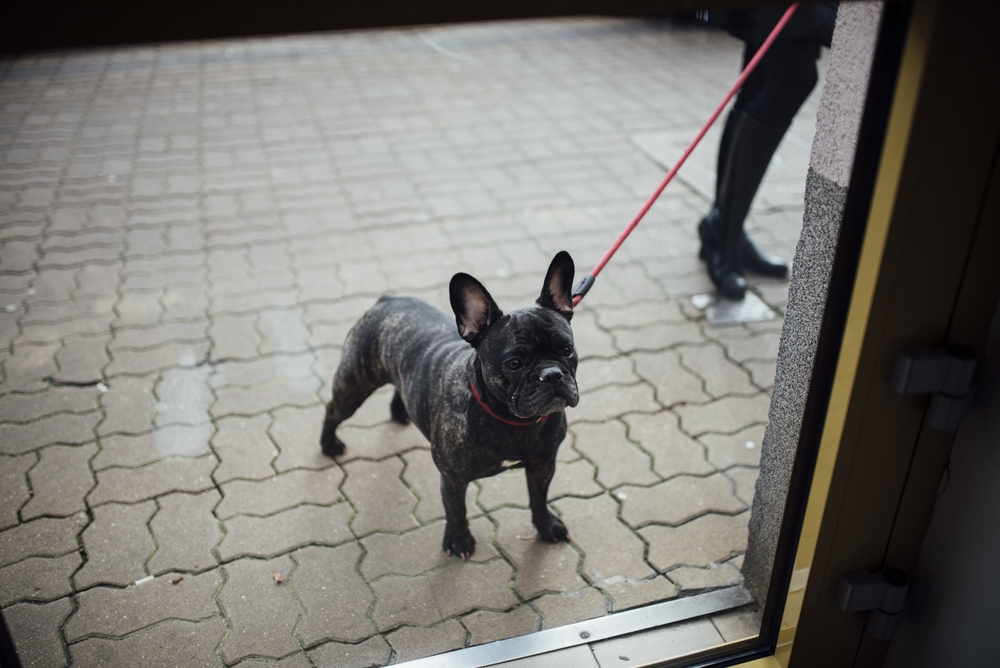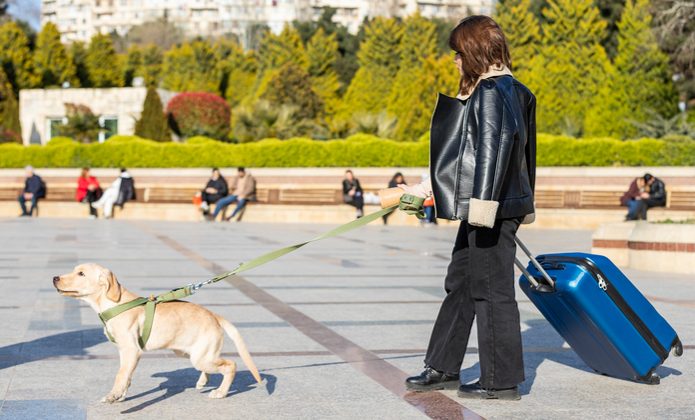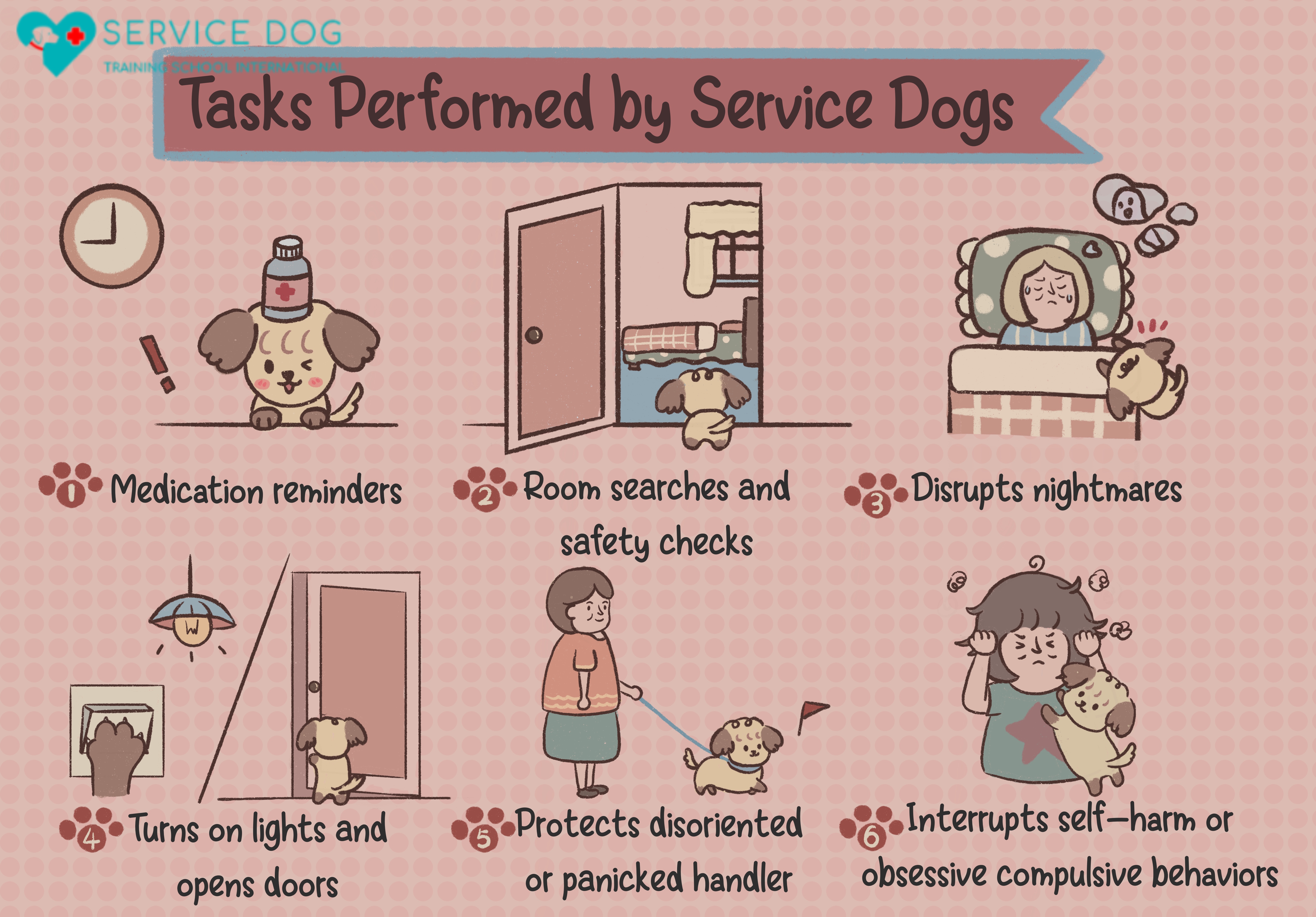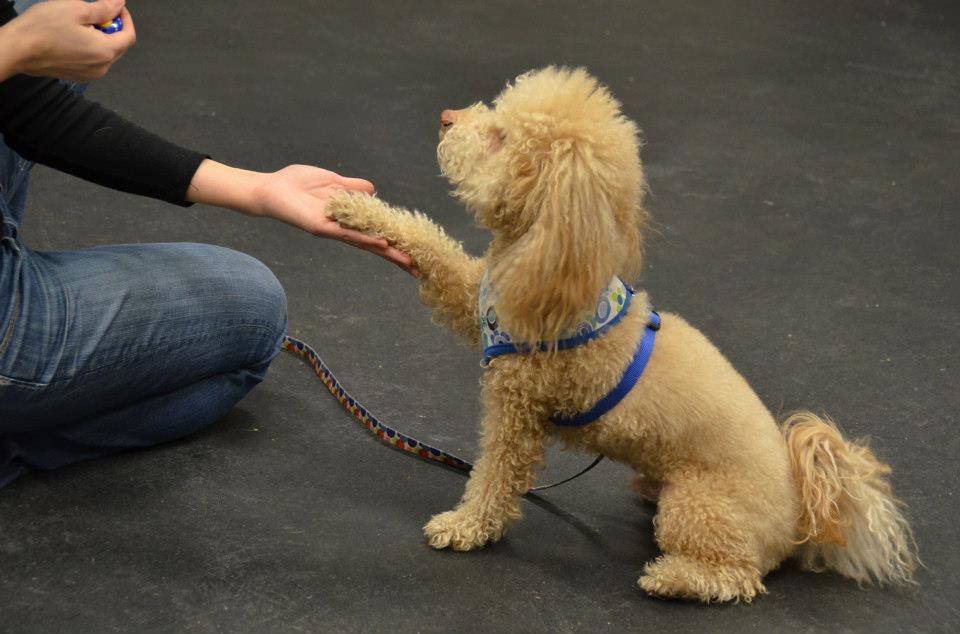
What do you imagine when you hear the term “service dog”? Is it a highly trained dog, who wears some sort of identification gear such as a harness, a vest or a jacket and supports his/her handler? However, in order for service dogs to become so impeccable in their manners and behave properly, they may need to go a long way... Service dog training always begins with the basics prior to moving to the advanced tasks. The basics are essential to ensure that a dog knows how to behave around other animals and people, especially while in public.
Having said that, today we will talk about service dog training in public. We will explain why it is so important and will also list several service dog tasks, that are essential for service animals in public.

What Are Service Dogs?
Most of you are likely to be already aware of the nature of service animals. However, since there are still people, who do not know what the term exactly means, we will explain it once again. Service animals are dogs only, they go through individual training to do specific work directly related to a disability. They support one person and are considered their medical equipment. If you are a U.S. citizen you may want to know that miniature horses are recognized as service animals in some U.S. states.
Service Animals are not Therapy Animals (TAs) nor are they
Emotional Support Animals (ESAs). TAs and ESAs are companion animals,
who do not perform specific tasks directly related to a disability.
Unlike ESAs, who support one person, providing comfort to them thanks
to their presence, TAs provide comfort to many people in designated
facilities such as hospitals, schools, and nursing homes.
Service Dog Training-Minimum Requirements for Public Access
Since we have already clarified the difference between the different types of assistance animals, let’s take a look at the training that a dog must go through to be recognized as a service animal. As mentioned at the beginning of the article, service animals must know basic obedience before they go through specialized training and learn specific tasks that will mitigate the symptoms of a disability.
Teaching a dog how to behave begins at the moment he/she enters your home. Of course, if we are talking about a puppy, training should begin with the very basics such as potty training, crate training, and socializing the pup. Puppies are nothing less than children who are in the process of exploring the world, and it is our role to properly teach them how to behave.
Play training and rewarding the pup for showing the wanted behavior are essential for shaping and reinforcing good behaviors. It is always better to teach a pup new behaviors instead of correcting bad ones in case they develop in the future.
Age
As a general rule, dogs must be at least 6 months old to be recognized as service animals. Physically demanding tasks require a dog to have reached full physical maturity. The age at that dogs become physically mature basically depends on the breed-smaller breeds get mature sooner than large breeds (at the age of 8–9 months, compared to 1- 1.5 years). Extra large breeds are likely to get physically matured at the age of 2 years.
Training Hours
Internationally recognized organizations like Assistance Dog International (ADI) require service animals to go through 120 hours of training and at least 30 hours of that term should be spent outdoors, so dogs learn how to behave properly in public.
Basic Obedience
As mentioned at the beginning of the article, service animals should know basic obedience before they go through specialized advanced training. Basic obedience includes commands that you are likely to already know, such as “sit”, “stay”, “come”, and “down”, and walking on a leash, including “heel”. However, service animals need also to go through focus training, as it is essential for developing their skill to remain focused on the handler. This skill, which can be applied to the training process as the commands “look at me” or “watch me”, is crucial while in public, where there are many distractions.
Clicker training is very helpful to teach dogs new behaviors, however, it is not mandatory and some handlers prefer to stick to vocal commands only or use other types of items that produce distinctive sounds. The idea of clicker training is very simple-every time a dog does the “right thing”, his/her handler needs to click to mark that behavior and reward the dog immediately. That way the dog will learn that a click means a treat.
The following article might help you learn more about puppy training and how to teach a pup basic obedience: “Puppy Basic Obedience 101”.
Good Manners
What is actually meant by “good manners”? We will list below several types of behaviors that service dogs should or should not exhibit while in public.
They should:
-be calm and not show signs of aggression;
-ignore distractions in their surroundings, including other animals, people, sounds or smells;
-walk calmly on a leash without pulling;
-fulfill the given commands;
They should not:
-relieve themselves in public places, unless in proper areas;
-jump at other animals or passersby;
-seek attention;
-seek food;
-excessively sniff around;
-show signs of aggression;
-bark unless this is a part of the service dog tasks they perform.
Specialized Service Dog Tasks
Once a dog goes through basic obedience, he/she should be trained to perform specific tasks related to a disability. These tasks vary from a person to person, and they can be both physically and/or mentally related. Furthermore, service dog tasks can be divided into alert tasks and response tasks. Alert tasks are designed to notify the handler about an oncoming event (episode), so they can take precautions. Response tasks help handlers after an episode has already occurred.
Examples of service dog tasks are:
-Alerting to anxiety, high/low blood sugar levels, seizures, migraine episodes...etc.;
-Alerting to specific sounds;
-Retrieving items such as a phone or medication;
-Opening/closing doors;
-Turning lights off/on;
-Guiding a person with visual impairments;
-Fulfilling mobility tasks such as helping a person keep balance;
-Pulling a wheelchair;
-Notifying a family member or passersby that the handler needs help;
-Dialing 911;
-Performing Deep Pressure Therapy or other types of tactile stimulation such as nose-nudging, pawing, and giving a kiss.

Do Service Dogs in Training Have Access to Public Places?
It basically depends on the local laws. Most U.S. states guarantee service animals in training the same access rights as fully trained service animals. You can find further information in our article “Service Dogs in Training (SDiT) State Laws”. Both SDiT and fully trained SDs must behave properly, otherwise, they can be excluded from public premises.
It is important to note though, that SDiT are not protected under the Americans with Disabilities Act (ADA), nor are airlines required to accommodate them in the passenger cabin. However, some airlines accept service dogs in training in passenger cabins. In this case, handlers are likely to need to show some sort of verification that the dog is in training or explain what types of tasks he/she is being trained to perform.
What Are Your Responsibilities as a Handler While in Public With Your Service Dog?
As a service dog handler, you should make sure that your dog is always under your control (be on a leash or otherwise tethered) and behaves appropriately. You and your dog should develop a strong bond with each other and get attuned to each other’s needs in order for the training to go smoothly and be most effective.
You should take care of your service animal both physically and mentally. By regularly bringing him/her to a veterinarian for annual exams (the frequency of the exams might be different based on the dog’s age), making sure that he/she is vaccinated, and goes through parasite control, you contribute to increasing the lifespan of your paw friend.
Physical health does not include veterinary visits only though, but also regular walks and exercises. Play sessions are also important for keeping a dog physically and mentally stimulated. Feeding your dog whether a pet dog or a service dog healthy food and keeping him/her on a balanced diet will have a positive impact on his/her health. Service animals should appear healthy and taken care of while in public.
Service dog handlers need to get informed about the local laws in their state/area/region/province to make sure that their dog meets all the requirements to be recognized as a service animal.
Conducting training properly and behaving respectfully towards your paw partner is also an essential part of your responsibilities as a handler. We would recommend the use of humane training methods only, which will keep the dog motivated and happy. Although some trainers are still using restrictive devices such as e-collars, we do not consider these appropriate training tools. They can be helpful (when used under supervision) to teach a dog certain behaviors but are not likely to contribute to strengthening the bond between a dog and a handler. As mentioned above, having a strong bond is crucial for successful training. Also, such devices can cause stress and fear in dogs and result in unwanted behaviors in the future.
You should carry supplies such as poop bags and be ready to clean after your dog. This point actually refers to both pet dogs and service animals and is among the main responsibilities of dog owners.
Educating the public about the nature of service animals is a point that still brings some negative feelings in many service dog handlers... You should be ready to face situations where passersby ask you about your disability, or your dog and even try to pet him/her (especially valid for small service dogs). You are likely to say “They do not have the right to do that!”. Yes, you are correct! However, things won’t change until the public gets educated about what it is allowed and not allowed to do. Service dog training gear such as a vest or a harness might be helpful to prevent passersby from approaching your dog. However, this is not always the case. It is important that you try to be friendly and remain calm while explaining why it is not appropriate for the dog to be petted and why you can not be asked personal questions about your disability.
Do not forget that as a service dog handler, you are a representative of the service dog community and as such, you should also behave appropriately.











